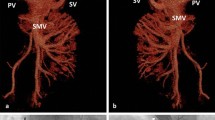Abstract.
We examined the etiology of a long-term postoperative complication, pulmonary arteriovenous malformation (PAVM), in a patient who underwent total cavopulmonary shunt (TCPS). The patient underwent TCPS at the age of 3 years and 1 month, and a PAVM developed. At the age of 10 years, TCPS was switched to total cavopulmonary connection to facilitate circulation of hepatic venous blood to the pulmonary artery. As a result, oxygen saturation increased. These findings suggest that the absence of pulmonary circulation of hepatic venous blood is involved in the development of PAVM.
Similar content being viewed by others
Author information
Authors and Affiliations
Rights and permissions
About this article
Cite this article
Shinohara, T., Yokoyama, T. Pulmonary Arteriovenous Malformation in Patients with Total Cavopulmonary Shunt: What Role Does Lack of Hepatic Venous Blood Flow to the Lungs Play?. Pediatr Cardiol 22, 343–346 (2001). https://doi.org/10.1007/s002460010243
Published:
Issue Date:
DOI: https://doi.org/10.1007/s002460010243




